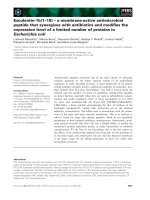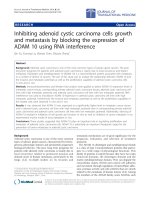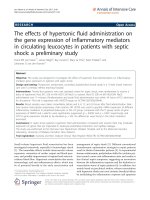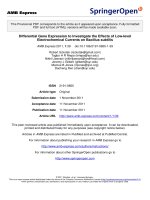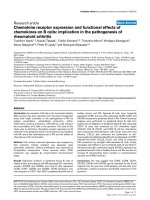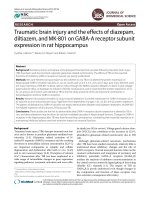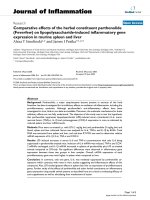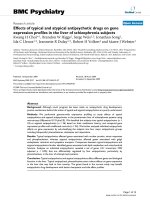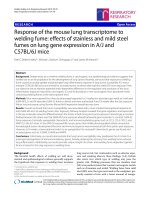The effects of RNA interference on the expression level of pea aphid ( acyrthosiphon pisum) sugar transporter gene (ap ST1)
Bạn đang xem bản rút gọn của tài liệu. Xem và tải ngay bản đầy đủ của tài liệu tại đây (1.67 MB, 65 trang )
❉✉r❤❛♠ ❊✲❚❤❡s❡s
❚❤❡ ❡✛❡❝ts ♦❢ ❘◆❆ ✐♥t❡r❢❡r❡♥❝❡ ♦♥ t❤❡ ❡①♣r❡ss✐♦♥ ❧❡✈❡❧
♦❢ ♣❡❛ ❛♣❤✐❞ ✭ ❆❝②rt❤♦s✐♣❤♦♥ ♣✐s✉♠✮ s✉❣❛r tr❛♥s♣♦rt❡r
❣❡♥❡ ✭❆♣❴❙❚✶✮
❆▲❖❚❆■❇■✱ ◆❖❍❆✱❆❇❉❯▲▲❆❍✱❙
❍♦✇ t♦ ❝✐t❡✿
❆▲❖❚❆■❇■✱ ◆❖❍❆✱❆❇❉❯▲▲❆❍✱❙ ✭✷✵✶✶✮ ❚❤❡ ❡✛❡❝ts ♦❢ ❘◆❆ ✐♥t❡r❢❡r❡♥❝❡ ♦♥ t❤❡ ❡①♣r❡ss✐♦♥ ❧❡✈❡❧ ♦❢ ♣❡❛
❛♣❤✐❞ ✭ ❆❝②rt❤♦s✐♣❤♦♥ ♣✐s✉♠✮ s✉❣❛r tr❛♥s♣♦rt❡r ❣❡♥❡ ✭❆♣❴❙❚✶✮✱ ❉✉r❤❛♠ t❤❡s❡s✱ ❉✉r❤❛♠ ❯♥✐✈❡rs✐t②✳
❆✈❛✐❧❛❜❧❡ ❛t ❉✉r❤❛♠ ❊✲❚❤❡s❡s ❖♥❧✐♥❡✿ ❤tt♣✿✴✴❡t❤❡s❡s✳❞✉r✳❛❝✳✉❦✴✸✸✸✺✴
❯s❡ ♣♦❧✐❝②
❚❤❡ ❢✉❧❧✲t❡①t ♠❛② ❜❡ ✉s❡❞ ❛♥❞✴♦r r❡♣r♦❞✉❝❡❞✱ ❛♥❞ ❣✐✈❡♥ t♦ t❤✐r❞ ♣❛rt✐❡s ✐♥ ❛♥② ❢♦r♠❛t ♦r ♠❡❞✐✉♠✱ ✇✐t❤♦✉t ♣r✐♦r ♣❡r♠✐ss✐♦♥ ♦r
❝❤❛r❣❡✱ ❢♦r ♣❡rs♦♥❛❧ r❡s❡❛r❝❤ ♦r st✉❞②✱ ❡❞✉❝❛t✐♦♥❛❧✱ ♦r ♥♦t✲❢♦r✲♣r♦✜t ♣✉r♣♦s❡s ♣r♦✈✐❞❡❞ t❤❛t✿
•
❛ ❢✉❧❧ ❜✐❜❧✐♦❣r❛♣❤✐❝ r❡❢❡r❡♥❝❡ ✐s ♠❛❞❡ t♦ t❤❡ ♦r✐❣✐♥❛❧ s♦✉r❝❡
•
❛ ❧✐♥❦ ✐s ♠❛❞❡ t♦ t❤❡ ♠❡t❛❞❛t❛ r❡❝♦r❞ ✐♥ ❉✉r❤❛♠ ❊✲❚❤❡s❡s
•
t❤❡ ❢✉❧❧✲t❡①t ✐s ♥♦t ❝❤❛♥❣❡❞ ✐♥ ❛♥② ✇❛②
❚❤❡ ❢✉❧❧✲t❡①t ♠✉st ♥♦t ❜❡ s♦❧❞ ✐♥ ❛♥② ❢♦r♠❛t ♦r ♠❡❞✐✉♠ ✇✐t❤♦✉t t❤❡ ❢♦r♠❛❧ ♣❡r♠✐ss✐♦♥ ♦❢ t❤❡ ❝♦♣②r✐❣❤t ❤♦❧❞❡rs✳
P❧❡❛s❡ ❝♦♥s✉❧t t❤❡ ❢✉❧❧ ❉✉r❤❛♠ ❊✲❚❤❡s❡s ♣♦❧✐❝② ❢♦r ❢✉rt❤❡r ❞❡t❛✐❧s✳
❆❝❛❞❡♠✐❝ ❙✉♣♣♦rt ❖✣❝❡✱ ❉✉r❤❛♠ ❯♥✐✈❡rs✐t②✱ ❯♥✐✈❡rs✐t② ❖✣❝❡✱ ❖❧❞ ❊❧✈❡t✱ ❉✉r❤❛♠ ❉❍✶ ✸❍P
❡✲♠❛✐❧✿ ❡✲t❤❡s❡s✳❛❞♠✐♥❅❞✉r✳❛❝✳✉❦ ❚❡❧✿ ✰✹✹ ✵✶✾✶ ✸✸✹ ✻✶✵✼
❤tt♣✿✴✴❡t❤❡s❡s✳❞✉r✳❛❝✳✉❦
✷
The effects of RNA interference on the expression level of
pea aphid ( Acyrthosiphon pisum) sugar transporter gene
(Ap_ST1)
Noha Abdullah Al-Otaibi
School of Biological and Biomedical Sciences
Durham University
MSc Thesis
2011
Supervisor: Dr J A Gatehouse
Abstract
Abstract
The pea aphid (Acyrthosiphon pisum) is a serious pest which attacks a number of important
crops worldwide, including grains, corn, potatoes and alfalfa, and it spreads viral diseases
among the plants it feed on. It reproduces sexually and asexually and, since it occurs within a
short period aphids can establish many colonies and spread easily. Interestingly, it has been
found that pea aphids have a high number of sugar transporter facilitator encoding genes, and
the most highly expressed of these is Ap_ST1, which is expressed in the aphid’s gut, which
functions as a transporter for the sugar molecules; mainly mannose and glucose.
The newly discovered tool RNA interference (RNAi) has become a powerful technique to
improve plants resistance against insects due to its high specificity. This study demonstrates
that using conventional dsRNA against the sugar transporter gene Ap_ST1 reduces the gene’s
expression level. Using a range of dsRNA concentrations proves that RNAi trigger effect can
be occur when applying dsRNA in a small quantity. The effect of RNAi was only observed
on the gene expression level and there was no alteration noticed on the phenotype or the pest
movement. This is due to the presence of the other sugar transporter encoding gene Ap_ST3,
which facilitates the transportation of the sugar molecules into the gut. Thus, this study shows
that RNAi could be a promising alternative biological tool in the control and management of
pea aphids.
i
Abbreviations
Abbreviations
Amino acids abbreviations
Amino acid
Glycine
Alanine
Valine
Leucine
Isoleucine
Methionine
Phenylalanine
Proline
Serine
Threonine
Cysteine
Tyrosine
Asparagine
Glutamine
Aspartic acid
Glutamic acid
Lysine
Arginine
Histidine
Single letter
G
A
V
L
I
M
F
P
S
T
C
Y
N
Q
D
E
K
R
H
DNA
Deoxyribo Nucleic Acid
cDNA
Complementary DNA
RNA
Ribonucleic acid
RNAi
Ribonucleic acid interference
TMV
Tobacco mosaic virus
siRNA
Small interfering RNA
dsRNA
Double stranded RNA
mRNA
Messenger RNA
ssRNA
Small stranded RNA
RISC
RNA-induced silencing complex
ATP
Adenosine triphosphate
GSP
Gene specific primers
nt
Nucleotide
ii
Contents
Table of Contents
Abstract .......................................................................................................................................... i
Abbreviations ............................................................................................................................ ii
Table of Contents ...................................................................................................................... ii
Table of Figures ........................................................................................................................ iii
Acknowledgements ........................................................................................................................... 1
Chapter 1 INTRODUCTION ................................................................................................................. 2
1.1 The need to protect crops ........................................................................................................ 2
1.2 Aphids as a model agricultural pest .......................................................................................... 4
1.2.1 Pea aphids (Acrythosiphon pisum) Morphology and life cycle ............................................ 5
1.2.2 The specialization of host plants ........................................................................................ 7
1.3 Sugar transporter proteins ....................................................................................................... 7
1.3.1 Sugar transporter encoding genes in pea aphids ............................................................... 8
1.3.2 The sugar transporter gene Ap_ST1................................................................................... 9
1.4 RNA interference ................................................................................................................... 11
1.4.1 RNA interference discovery ............................................................................................. 11
1.4.2 RNA interference mechanisms ........................................................................................ 12
1.4.3 RNA interference uptake ................................................................................................. 15
1.4.4 RNA interference applications ......................................................................................... 16
1.5 Aims and the objectives of the study...................................................................................... 18
Chapter 2 MATERIALS AND METHODS ......................................................................................... 19
2.1 Chemicals and materials .................................................................................................... 19
2.2
Common reagents, solutions and chemical recipes ....................................................... 19
2.3
Standard molecular biology techniques: ....................................................................... 22
2.3.1
Preparation of electrocompetent cells for transformation .................................... 23
2.3.2
Bacterial culture...................................................................................................... 23
2.3.3
Plasmid DNA purification from transformed E.Coli .................................................... 23
2.3.4
Restriction endonuclease digestion .......................................................................... 24
2.3.5
Precipitation of nucleic acids .................................................................................... 24
2.3.6
Agarose gel electrophoresis ...................................................................................... 24
2.3.7
Recovery of DNA fragments from agarose gel ........................................................... 25
2.3.8
Quantitation of nucleic acids .................................................................................... 25
iii
Contents
2.3.9
DNA ligation ............................................................................................................. 25
2.3.10
E. coli transformation ............................................................................................... 26
2.3.11
RNA extraction ......................................................................................................... 26
2.3.12
Amplification of the plasmid carrying the gene Ap_ST1 ............................................ 27
2.3.13
Sub-cloning of Ap_ST1 fragment in PJet .................................................................... 27
2.3.14
Screen of isolated plasmid DNA for correct insert ..................................................... 28
2.3.15
DNA sequences analysis ........................................................................................... 28
2.3.16
Synthesis of double stranded RNA (dsRNA)............................................................... 28
2.3.17
Reverse transcription PCR (RT-PCR) .......................................................................... 29
2.3.18
Quantitative polymerase chain reaction (qPCR) ........................................................ 30
2.4
Maintenance of pea aphids culture .............................................................................. 31
2.5.1 Feeding bioassay (1) ........................................................................................................ 31
2.5.2 Measuring aphids bodies length ...................................................................................... 32
2.5.3 Feeding bioassay (2) ........................................................................................................ 32
Chapter 3.0 RESULTS ................................................................................................................... 33
3.1.1 Clone and sub-clone of Ap_ST1 in litmus 28i ....................................................................... 33
3.1.2 Synthesis and preparation of dsRNAs .................................................................................. 36
3.1.3 The stability of dsRNA ..................................................................................................... 37
3.2 Bioassay................................................................................................................................. 38
3. 2.1 Effects of dsRNA on the expression level of the target gene (experiment 1) ................... 38
3.2.2 Effects of dsRNA on Ap_ST1 expression level (experiment 2) ........................................... 39
3.2.3 Bioinformatic Analysis......................................................................................................... 40
3.3 Measuring the examined aphids growth ................................................................................ 41
4.0 Discussion .............................................................................................................................. 44
4.1 Conclusions............................................................................................................................ 47
4.2 Future Research ..................................................................................................................... 47
REFERENCES ................................................................................................................................ 48
iv
Figures
Table of Figures
Figure 1: Pea aphid (Acyrthosiphon pisum). It is a common pest in some host plants such as alfalfa,
red clover .......................................................................................................................................... 6
Figure 2: Predicted structure of the sugar transporter protein Ap_ST1 and its 12 transmembrane
helices.. ........................................................................................................................................... 10
Figure 3: The sequence of the predicted protein sequence of the gene Ap_ST1 contains 490 amino
acids residues.. ................................................................................................................................ 10
Figure 4: The pathway of RNA interference. .................................................................................... 14
Figure 6 : Aphids feeding cage. ........................................................................................................ 32
Figure 7: The PCR product of the amplified sugar transporter encoding gene Ap_ST1 from the
recombinant plasmid ....................................................................................................................... 34
Figure 8: the selected sequence of Ap_ST1 for dsRNA synthesis. ..................................................... 34
Figure 5: Schematic diagram for construction of Litmus 28i Ap_ST1, and Litmus 28i Kanamycinresistance gene. .............................................................................................................................. 35
Figure 9: The digestion of the segments of cloned genes Ap_ST1 and Kanamycin resistance gene in
p.JET............................................................................................................................................... 35
Figure 10: Visualization of the in vitro synthetic annealed dsRNAs.. ............................................... 36
Figure 11: The stability of dsRNA during the test. ............................................................................ 37
Figure 12: qRT-PCR quantitation of RNAi mediated gene silencing of Ap_ST1 expression in pea
aphids. ............................................................................................................................................. 39
Figure 13: RNAi mediated effects on the expression level of Ap_ST1. ............................................. 40
Figure 14: Mutiple sequences alignment of sugar transporter Ap_ST1 and other predicted genes,
Ap_ST16 and Ap_ST17. .................................................................................................................... 41
Figure 15: The effect of RNAi on the pea aphids. ............................................................................. 42
Figure 16: Surviving pea aphids from different examined groups. .................................................... 43
v
Acknowledgements
Acknowledgements
I would like to gratefully thank Professor Gatehouse for giving me the opportunity to work in
his lab. Without his assistance, this thesis would not have been completed. It is a pleasure to
thank the research group: Dr. Daniel Price, Dr. Prashant Pyati Dr. Catherine Bruce, Dr.
Elaine Fitches, Emma Back, Gareth Hinchliffe and Dominic Wood for their cooperation and
for creating a friendly working environment.
I would also like to thank Sid and Dr. Jen Topping and Dr.Knight for their help and
assistance in the last period of my research. A special thankyou goes to Dr. Bashir for her
constant support and guidance and endless kindness throughout my journey in Durham.
I would like to thank my friends in Durham; Nigel, Bagus, Maher, Bassam, Ana, Mwape,
Emma Mclaughin and the others for their support and making Durham such a wonderful
place to live in. My gratitude extends to my best friend Ohoud Al Muhammadi for her
support and for being such a great friend despite being far away.
Finally, I thank my parents who have always given me the courage to pursue my dreams.
Thanks to all my brothers and my sisters for being such a nice family.
1
Introduction
Chapter 1 INTRODUCTION
1.1 The need to protect crops
Crop protection and world food security are two faces of the same coin because crop yields
need to increase to allow more food to be grown on a land area that is shrinking. They have
become real global concerns as a result of the continuous growth in the world’s population,
which is predicted to rise to more than 8 billion within the next fifteen years. According to
McCalla (1994), this prediction, along with increases in individual incomes and urbanization,
means that food supplies need to be more than doubled by 2025. Therefore, the factors that
can limit agricultural production need to be studied in order to increase crop yields.
Pest infestations cause both direct and indirect damage to crops, and pose a grave threat to
agriculture. Worldwide, it is estimated that there are 10,000 species of insects and mites,
30,000 weed species and 100,000 species of plant pathogens that attack crops, and more than
60% of crops pests are considered to have serious effects on world crop production ( Hall,
1995; Dhaliwal, el al., 2007; UNEP, 2010). These pests cause crop losses estimated at
millions of dollars.
Direct losses are caused where the pest consumes or damages crops. For example, locusts,
which spread in warm regions, destroy grasses and cereals. The average daily consumption of
locust nymphs is estimated to be 100-450 mg of green plants per day, and the adults each
consume 0.2g per day (Roberts, 2010).The moth Helicoverpa zea’s larva causes significant
damage to a wide range of crops, including cotton, tomato and corn, and it is difficult to
control (Capinera, 2000).
Pests can also cause indirect damage by acting as vectors for plant diseases or by damaging
beneficial organisms. For example, the whitefly Bermisia tabaci transmits 140 different
viruses that cause plant diseases and thus causes significant losses in crops such as melon,
tomato and beans (Jones, 2003). A serious pest in honeybee hives, the varroa mite, causes
annual losses in free pollination services from feral bees estimated at 30 million dollars a year
(CSIRO, 2008). Lately, the same mite invaded beehives in New Zealand where it is
2
Introduction
anticipated that it will cost between 267 and 602 million dollars to deal with its effects and
cause beekeepers to change the way they manipulate their hives (GISP, 2008).
Pest and pathogen invasions have caused serious reductions in crop yields in the most food
insecure and poorest regions in Africa, where the damage has been assessed to cost $12.8
billion annually (Oerke et al., 1994). Oerke (1994) reports that pests may reduce potential
crop yields by 50% in developing countries.
Environmental change, including climate
change due to increasing atmospheric CO2, could promote and alter insects’ distribution and
cause further invasion (Macdonald, 1994; Vilà et al. 2006; Wallingford, et al., 2009).
For many years, insect pest control in agriculture has been based on the use of chemical
pesticides. However, widespread use of these compounds has had harmful consequences,
such as soil and water contamination, and harmful side-effects on human and animals. Hence,
there is a need to find plant protection methods that are friendly to the environment,
consumers and farmers.
Genetic modification (GM) techniques offer some alternative options to improve and protect
crops against environmental conditions, including insect interactions, by manipulating the
genetic materials of plants and introducing resistant genes from different species into them.
For example, rice, cotton and maize have been manipulated to produce Bacillus thuringiensis
δ-endotoxin protein (Bt toxin), a toxic protein which interacts in the insects’ gut to produce
lethal lesions (Mazier et al., 1997). The introduction of the encoding gene sequence to plants
has been shown to have a toxic effect in a number of insects, such as the European corn
borer, potato beetle and cotton bollworm. Crops which produce Bt toxin proteins show a
biological resistance to insects without the need to use chemical pesticides (Feitelson and
Payne, 1992; Knowles and Dow, 1993). The specificity of Bt toxins to specific insect species
is an advantage because using such a technique reduces the effects on humans, animals, other
organisms and non-target species. Also, some modified plants can express two or more toxic
proteins and this has raised their protection efficiency against a number of pests and has
reduced the damage to crops (Gatehouse, 2008).
However, since Bt toxins are not effective against some important insect pests, such as
phloem feeders, alternative methods for engineering plants for insect resistance have been
studied. Effective bio-insecticide approaches, such as inserting genes encoding toxic
insecticidal proteins into plants, have been described (Celia, et al., 2002). For example, the
expression of the biotin-binding protein avidin enhances the resistance of plants to insects. It
3
Introduction
has been reported that avidin expressed by maize showed resistance to three different
coleopteran larvae (Karmer, 2000). Producing secondary metabolite compounds in suitably
engineered transgenic plants is another approach which can result in increased insect
resistance (Gatehouse, 2008). Currently, research is being carried out on processes which can
be used to activate specific genes to stimulate plant pest management (Thayer, 1999), or to
knockdown important genes in plant enemies. Using the RNA interference technique to
knockdown genes in pests has been shown to be a feasible method of controlling insects and
other invertebrates (Baum, et al., 2007).
In spite of all the controversies around the genetic engineering of crops, there is little doubt
that GM applications will play an important role in the near future in increasing food supplies
to the growing world population. Not only is GM beneficial and less harmful to the
environment than agrochemical approaches, furthermore, it also has the potential to enhance
nutritional values, increase crop yields and decrease inputs of chemicals and energy in crop
production. Also, GM can enable farmers to selectively target and destroy weeds without
damaging crops (Uzogara, 2000).
1.2 Aphids as a model agricultural pest
Aphids are small plant sucking insects which belong to the super family Aphidodiea. This
group of insects are serious pests which infest almost all the major crops, including grains,
corn, potatoes and alfalfa. They are usually found on plant stems or the undersides of leaves.
They cause damage to their host plants by feeding on their phloem sap, which weakens the
plants and causes curled and faded leaves, or by transmitting plant pathogens by acting as a
vector to transfer viruses causing diseases. Although the damage caused to plant tissues by
these insects is usually minimal, the holes created by their probing can help to cause fungal
infection (Jones and Jones, 1974). Aphids generally do not cause phloem blockage, as is the
case for some other phloem feeders, such as the rice brown planthopper. However, in
addition to phloem feeding, aphids secrete honeydew, which is composed of unused sugary
liquid from the phloem sap and some other waste products, and which is a medium for the
growth of a black fungus called ‘sooty mould’. The growth of this surface fungus negatively
affects the quality and the quantity of the crop yield. But, the primary damage that aphids
4
Introduction
cause to crops is their ability to transmit and spread plant viral diseases (Blackma and Eastop
2000; Nault, 2004). Jones and Jones (1974) report that they transmit more than thirty viral
diseases. However, feeding can also result in plant death or deformation of crops. Thus,
aphids cause considerable financial loss to farmers. Oerke (1994) and Morrison and Peairs
(1998) estimate that, in the US alone, aphids cause an annual loss of hundreds of millions of
dollars.
There are around 5,000 species of aphids (Remaudiere and Remaudiere 1997), divided into
10 families, and 250 aphid species are considered to be significant agricultural pests. Aphids
are mostly found in the temperate climate regions but their worldwide distribution is due
either to the climate factor or to humans transporting of plants carrying aphids to different
regions.
1.2.1 Pea aphids (Acrythosiphon pisum) Morphology and life cycle
Pea aphids are small green insects with a soft, pear shaped body. Adults are usually less than
3 mm in length. They have long antennae folded back over the body, and a pair of cornicles
in the fifth segment of their back, through which they excrete honeydew fluid that is believed
to play a role in their defence mechanism (Figure 1). They penetrate plant surfaces with their
proboscis and use the partially enclosed stylet to probe between cells to the vascular tissue,
where they penetrate the sieve elements to suck phloem sap, ingesting it passively using the
pressure of the vascular system. The phloem sap contains high levels of sucrose (up to 1M)
(Ashford et al., 2000) as a carbohydrate source, and free amino acids, which are used as a
source of nitrogen for nutrition. Pea aphids are normally wingless but the adults produce
offspring able to develop wings when colonies become overcrowded or when the host plants
become senescent or moribund. These enable them to travel to other plants and form new
colonies.
5
Introduction
Figure 1: Pea aphid (Acyrthosiphon pisum). It is a common pest in some host plants such as alfalfa, red clover. It causes a
serious damage to crops due to its ability to propagate fast and the feeding habit (Rice, 2006).
Aphids have an interesting and complex life cycle, which seasonally alters between sexual
and asexual reproduction. Their reproduction process involves asexual (parthenogenetic)
reproduction which is followed by sexual reproduction (holocyclicMonocyclic) in the
autumn, or it may involve only parthenogenetic generation (anholocyclic). This mainly
occurs in warm climate regions and tropical zones or during the spring and summer.
Interestingly, the anholocyclic aphids show a distinctive variation in the genotype among the
population (Blackman, 1979) because each female produces genetically identical female
offspring which continue to produce another such generation. Daughter embryos carry their
embryos within the mothers’ ovarioles; thus aphids can develop their daughters and granddaughters within the same generation. Aphid ‘mothers’ give live birth to first instar nymphs.
Around 7-10 days later, after the nymphs have progressed through four nymphal instars, they
become adult females which are able to produce offspring. Female aphids produce up to 200
live young during their lifespan, with an active reproduction phase of up to 20 days. In
winter, aphids respond to the shorter day length and colder weather and produce sexual
generation asexually (Lees, 1990). The males are produced through the random loss of one of
the X chromosomes because of a lack of attachment to spindle fibres in the metaphase
through the maturation division (Wilson et al., 1997). After intercourse between male and
female aphids, the female produces an egg containing a female embryo holding the
chromosomes XX. This may be because the sperm which carry chromosome X are the only
viable sperm. The eggs adapt to a very low temperature during the winter. In the spring,
6
Introduction
aphids’ eggs are hatched, resulting in new asexual female nymphs, which enter the same
production cycle and found new colonies.
It is clear that the aphids’ life cycle is controlled by genetic and environmental factors
(Dixon, 1963; Lees, 1964; Via, 1991). Most aphids’ generations are parthenogentic, carrying
live nymphs. Their high fecundity and short generational production period allows them to
grow their colonies very rapidly and become huge populations that are capable of destroying
crops.
1.2.2 The specialization of host plants
Although aphids are subject to genetic adaptation and speciation, some pea aphids are
generalist feeders while others prefer particular host plants, such as alfalfa, pea, leguminous
weeds or clover (Sandstrom, 1994; Via, 1991). The preference refers to the number of aphids
that accumulate on one plant species compared to another. When pea aphids are introduced to
a host plant, they determine if it is a suitable diet source by using their stylets to probe it
several times (Cailaud and Via, 2000). Field and laboratory studies indicate that an aphid’s
preference for a particular plant is established by inserting the stylet. The discrimination
occurs through brief probes of the plant (Johnson, 1958; Wensler, 1962;). The actual host
plant specialization is determined by the acceptability of the plant as a feeding resource. In
turn, this is determined by the ingestion of the food and breeding on the host plant while the
aphid probes the plant’s phloem sap (Schoonhoven et al.,1998; Tosh et al., 2003)
1.3 Sugar transporter proteins
Sugar molecules (monosaccharide) are an important biological resource for energy and
carbon, as well as providing monomeric components from which oligosaccharides and
complex carbohydrates, found as structural and recognition molecules in cells, are built up.
The transportation of sugar molecules into and out of cells is a vital process, which requires
transporter proteins to pass the molecules through the membranes of cells or organelles.
7
Introduction
Sugars are hydrophilic molecules which cannot cross biological membranes by diffusion.
There are many transporter proteins in the cellular membrane and they show diversity in
respect to the substrate and the transporting mechanism. Although many different types of
transporter exist, it is possible to use predicted amino acid sequences to extrapolate the
transporting proteins’ functions and structure, using information obtained from sequence
comparisons, and inferred phylogenetic trees which depend on the proteins phylogenetic
distances and their relationship to each other (Saier et al., 1999a). This method is only
appropriate if these proteins are related phylogenetically (Saier et al., 1999a).
Sugar transporter proteins belong to the major facilitator superfamily (MFS). This
superfamily consists of 29 families, in addition to possibly five other distant families (Saier et
al., 1999b). Eight families of MFS are classified as transporters for sugars and their
derivatives; three of them exist in almost all the living organisms (Saier et al., 1999b). Like
other proteins belonging to the MFS superfamily, sugar transporter proteins have 12
transmembrane α-helices and comprise of two sub-groups, symporters and uniporters.
Symporter proteins transport a specific substrate against its concentration gradient, using
energy obtained by co-transporting a second substrate (usually an ion) down a concentration
gradient. Uniporters move substrates down a concentration gradient, and thus transport is
determined by the concentration of the substrate on each side of the membrane spanned by
the transporter (Saier, 2000).
1.3.1 Sugar transporter encoding genes in pea aphids
In aphids, disaccharide sucrose is present at high concentrations in gut contents as a result of
phloem ingestion, with phloem sap having a higher osmotic pressure when compared to the
osmotic pressure of the aphid’s haemolymph (Karley et al., 2005). Sucrose is not transported,
but is digested to the hexoses glucose and fructose by a sucrase enzyme in the gut. Glucose
and fructose are transported through the cells of the gut epithelium to the aphid haemolymph.
Due to the high level of sugar in the gut, the transportation of sugar molecules from gut to
hemolymph could be facilitated by uniporter proteins, which mediate the transportation of
solute molecules from the gut to the hemolymph, across the epithelial cells, and the
movement could be controlled by concentration gradients. Supporting this hypothesis is the
fact that no sodium-sugar symporter proteins that facilitate transportation against the
8
Introduction
concentration gradient are present in a pea aphid’s genome, according to the bioinformatics
data (The international aphid genomics consortium, 2010).
Genomic studies (Price et al., 2010) show that the pea aphid genome contains a large number
of genes encoding transporter proteins, including about 200 genes encoding transporter
proteins belonging to the MFS. Superfamilies can be annotated with predicted functions
based on sequence similarity analysis. A pea aphid has 34 sugar/inositol transporter genes,
which is higher than the number of transporter genes in other insects such as Drosophila
melanogaster, which has 15 sugar transporter genes. The beetle Tribolium castaneum is an
exceptional since it has the highest number of the sugar transporter genes, it is containing 54
sugar transporter genes. The most highly expressed sugar transporter gene in pea aphids is
Ap_ST3, which encodes a uniporter protein with specificity towards both glucose and
fructose (Price et al., 2010).
1.3.2 The sugar transporter gene Ap_ST1
Ap_ST1 (LOC100160486) is a highly expressed gene in the digestive tract of A. pisum. It is
found specifically in the midgut region of the tract, with 5 expressed sequence tags (ESTs)
found in libraries from this tissue, which is higher than in other parts of the pea aphid’s body
(Price et al.). The gene Ap_ST1 encodes a sugar transporter protein (XP_001942953)
consisting of 489 amino acids residues (figure 3), giving 53.70 kDa as the predicted
molecular weight. It has a glycosylation site at the extracellular loop 4 (amino acid 303), as
shown in figure 2. The protein belongs to MFS superfamily and, like other members of this
protein superfamily, it is predicted to contain 12 transmembrane α-helices. It shares other
features with the major facilitator superfamily proteins. It has GRR/K motif in the
intracellular loop 1 and in the intracellular loop 4, and it has highly conserved glutamine
residues present in transmembrane helices 5 and 7, which are considered to be part of the
exofacial ligand binding site (Hashirmoto et al., 1992; Mueckler et al., 1994). Although the
motif –QLS-, which presents in some glucose transporters and is absent from
fructose/glucose transporters, does not exist in transmembrane helix 7 in the Ap_ST1 encoded
protein, a -QFS- motif sequence is present in this site. The Ap_ST1 product functions as a
carrier for mannose and glucose (Price et al., unpublished).
9
Introduction
Figure 2: Predicted structure of the sugar transporter protein Ap_ST1 and its 12 transmembrane helices. The
structure was predicted by using the program TMHMM.
Figure 3: The sequence of the predicted protein sequence of the gene Ap_ST1 contains 490 amino
acids residues. The sugar transporter protein Ap_ST1 is highly expressed in aphids’ gut (Price et al.,
unpublished). The produced protein transports mannose and glucose molecules. The gene sequence
is obtained from the NCBI, National Centre of Biotechnology Information, and processed by 5
Geneious.
10
Introduction
Multiple alignment of A. pisum sugar transporter genes, with a subsequent Clustal analysis to
construct a phylogenetic tree, as previously described (Price et al., 2009), shows that Ap_ST1
forms a sub-group with two other predicted sugar transporter proteins: Ap_ST16
(XP_001943804), which has 83% similarity to Ap_ST1, and Ap_ST17 (XP_001950031),
which has 84% similarity to Ap_ST1. Similar predicted genes are present in other aphids,
such as the aphid Sitobion avenae, which contains a homologous gene (Sa_ST1) with 96%
identical coding sequence to Ap_ST1, and sequences with a high similarity to Ap_ST1 are
present in other aphid species, such as Myzus persicae and Aphis gossyii. Similar proteins are
also present in other sap-sucking insects; the glucose transporter protein in the hemipteran
species Nilaparvata lugens (rice brown planthopper) has 70% similarity to the Ap_ST1
protein (Price et al., 2009).
1.4 RNA interference
1.4.1 RNA interference discovery
RNA interference (RNAi) is a newly discovered biological process which occurs in the
cytoplasm of cells and affects the expression level of specific genes in a selective process by
degrading the mRNA of target genes through a post transcriptional gene silencing process
(PTGS). The process is mediated by RNA sequences which are introduced into the cell as
exogenous RNA, usually as double stranded RNA (dsRNA), and it occurs after export of
mRNA from the nucleus. Studies of the nematode Caenorhabditis elegans have shown that
the injection of both sense (the strand which has an identical sequence to mRNA) and antisense RNA strands (the complementary sequence of mRNA) separately causes gene silencing
(Guo & Kemphues, 1995). Later, Fire and Mello (1998) conducted an experiment by
injecting a mixture of sense and anti-sense strands as dsRNAs into C. elegans and showed
that the dsRNA was ten times more effective in decreasing expression of the homologous
endogenous mRNA than using either the sense or the antisense strand alone. Since then, the
silencing of a certain gene using double stranded RNA has been called RNA interference.
RNAi shares similar mechanisms with a previously observed phenomenon, namely,
homology dependent gene silencing. Several years before Fire and Mello’s (1998) discovery,
11
Introduction
Richard Jorgensen and colleagues aimed to deepen the purple pigment of petunias by
introducing the colour producing gene, controlled by a powerful promoter. Surprisingly, the
experiment showed the unexpected result that many flowers were colourless or variegated.
This phenomenon was called ‘co-suppression’, due to the suppression of both the endogenous
and the homologous exogenous genes (Napoli et al., 1990; Jorgensen, 1990). Other studies
found that plants suppress the expression of viral RNA by a similar response (Dougherty et
al., 1994; Kumagai et al., 1995). It is clear that dsRNA, when exogenously introduced or
transcribed from engineered inserted DNA, is a potent gene silencing trigger in a plant’s
system (Bernstein et al., 2001). Co-suppression has been observed not only in plants, but also
in some other unicellular organisms, such as the fungus Neurospora crassa, where it was
called ‘quelling’ (Romano and Macino, 1992; Bernstien et al., 2001). It was also observed in
nematodes, protozoa, metazoans, and in mammals such as mice oocytes and Drosophila (Fire
et al., 1991; Pal-Bhadra et al., 1997).
In fact, the initial idea of inhibiting genes by using an external molecular material or part of a
pathogen's genetic material as a tool to generate a resistance was first put forward by
Sandford and Johnston (1985) who proposed that, if a host cell genome expressed a modified
genetic portion of the pathogen’s genetic material, it could act against the pathogen itself and
inhibit it. In 1986, the theoretical proposition was shown to be valid in a practical application
when a transgenic plant that contained and expressed the coat protein gene of the tobacco
mosaic virus (TMV) was generated. When the transgenic plant was exposed to TMV, it
exhibited resistance and delayed display of the symptoms of TMV infection (Abel et al.,
1986). Subsequent work linked this phenomenon to silencing of gene expression by RNA
interference. RNAi has been characterised as a naturally occurring gene expression regulator
(Ding et al., 2004), and also as a function in the defence mechanism against viruses (Hunter
and Poethig., 2003), and chromatin structure (Lippman and Martienssen, 2004).
1.4.2 RNA interference mechanisms
In the last decade, a large amount of research has been carried out in order to understand the
mechanisms of RNAi and to characterize the components which contribute to the gene
silencing process. According to recent studies, the RNAi process can be divided into three
12
Introduction
basic steps (Meister and Tuschl , 2004; Tomari and Zamore, 2005). The first step is the
processing of the long double-stranded RNA by an RNase III endonuclease termed Dicer
(Carmell and Hannon, 2004) into small interfering double stranded RNA (siRNA) fragments
consisting of 21-23 base pairs. The structure of the double stranded RNA is formed as a result
of matching two separated RNAs strands (sense and antisense) or by forming a stem-loop
structure within the strand itself and it could be exogenously introduced via a vector such as
virus or directly introduced or expressed in cells. The yielded siRNAs have phosphate groups
at their 5’ ends and 2 nucleotides overhangs at their 3’ ends (Hannon and Rossi, 2004;
Meister and Tuschl, 2004). Some Dicers have ATP-binding sites which suggest that ATP is
required for siRNA production (Ketting et al., 2001; Nykanen et al., 2001). siRNA has two
strands, sense and antisense, corresponding to a specific mRNA sequence. The antisense
strand can hybridise to this specific gene sequence, and therefore it acts as a guide to
recognize the target mRNA, as shown in figure 4.
Secondly, siRNAs assemble into a multiprotein RNA-induced silencing complex (RISC),
which consists of Dicer, RNA binding proteins, the TAR-RNA-binding protein (TRBP),
Argonaute (Ago), which forms the core component of RISC, and PACT (Lee et al., 2006).
Recently, the vasa intronic and dFMR product proteins were characterized as additional RISC
proteins (Caudy et al., 2002).
There is a strict requirement that the siRNA is 5’
phosophorylated to be attached into the protein complex, and the unphosophorylated siRNAs
are immediately phosophorylated by endogenous kinase (Schwarz et al., 2002). Short double
stranded RNA has to be unwound to allow the antisense strand to guide the complex proteins
to its homologous target mRNA during the incorporation, whereas the second strand is
degraded (Hammond et al., 2000; Schwaez et al., 2003; Khvorova et al., 2003). Dissociation
of the antisense and sense strand in siRNA needs Dicer-2 and R2D2 protein heterodimer (Lee
et al., 2004; Liu et al., 2003). Therefore, the antisense strand governs the remarkable
specificity of gene silencing in RNAi (Elbashir et al., 2001).
Thirdly, the guided strand (ssRNA) and RISC attach to the target mRNA and cleave it at a
single site, 10-11 nt upstream from the 5’end of the siRNA. This complementary interaction
causes an endonuclease specific degradation of mRNA around the central region of the
mRNA strand (Elbashir et al., 2001) and the cleavage of the complementary mRNA occurs
by the activity of RNaseH in Argonaute (Hammond, 2005). Eventually, the RISC dissociates
from the degraded mRNA and enters another catalysing cycle. This feature of RISC gives the
13
Introduction
silencing effect. In some organisms, ssRNAs are not produced from a dsRNA precursor but
they present naturally; thus RNase III is not involved in their production.
RNA-dependent RNA polymerase in some living organisms plays an important role in
siRNA amplification, thereby increasing the silencing affectivity of siRNA (Cogonu and
Macino 1999; Fire, 1999). In some organisms, such as mammals, long dsRNAs ≥30 nt are
able to stimulate an interferon response (Elbashir et al., 2001; Rutz and Scheffold, 2004),
causing nonspecific knockdown to gene expression. The introduced long dsRNA induce an
antiviral response, either by stimulating a series of activations starting with 2’-5’
oligodenylate polymerase which in turn activates RNase L, causing all RNA molecules to be
degraded and non-specific gene silencing, which results in a change in cellular gene
expression that leads to apoptosis (Minks et al., 1979), or by activating the protein kinase
(PKR). The activated PKR causes inactivation of the translation initiation factor, eIF2a, by
phosphorylation, resulting in translation suppression (Manche et al., 1992). However, not all
cells have the same response to long dsRNA and this made long dsRNA a possible choice in
specific gene silencing studies (Paddison et al., 2002; Yang et al., 2001).
Figure 4: The pathway of RNA interference. Small hairpin (shRNA) or dsRNA are cleaved by Dicer
depending on ATP to produce small interfering RNA (siRNA). The siRNA sequences bind to RISC
14
Introduction
depending on ATP molecule to form a complex which targets mRNA based on the corresponding
sequence to siRNA, then the complex siRNA RISC is released and enter another cycle (Hutvagner
and Zamore, 2002).
Interestingly, two genes encoding important proteins identified in the effector step in posttranscriptional gene silencing have been found in C. elegans, mut-7 and rde-2, which also
affect the transposon activity. C. elegans with inactivating mutations in mut-7 and red-2
showed a defective RNAi response, but also the transposon activity was increased. Therefore,
the suppression of transposons is controlled by a mechanism correlating to RNAi (Bastiaan et
al., 2005; Hannon, 2002).
1.4.3 RNA interference uptake
Several studies have described the uptake mechanisms of dsRNA by cells in different
organisms. The research has identified two required transmitter agents for systematic RNAi
by inducing mutations in the SID gene, using C.elegans as an animal model. The first
characterized protein is SID-1, which is a transporter protein consisting of a single
polypeptide and 11 transmembrane domains (Winston et al., 2002). This protein passively
transports dsRNA into the cells of C.elegans, but it does not export it to the neighbouring
cells (Winston et al., 2002; Jose et al., 2009).
SID-1 orthologs are found in different organisms, including the cotton aphid (Aphis gossypii),
the honey bee (Apis mellifera) and Tribolium castaneum (Xu and Han, 2008; Aronstein et al.,
2006; Tomoyasu et al., 2008). The study of the SID-1 ortholog gene expression level using
RNAi in the honey bee indicates a correlation between the expression level of the gene SID-1
and the knock down of the target gene (Aronstein et al., 2006). The study of the three
ortholog genes in T.castaneum shows no effect on systemic RNAi when silencing one or all
SID-1 orthologs (Tomoyasu et al., 2008). Intriguingly, further analysis of the SID-1
orthologues in insects showed that SID-1 orthologs are more similar to tag-130 genes than to
SID-1 in C.elegans. Tag-130 genes are not involved in the systemic RNAi in C.elegans,
which suggests that the SID-1 is not important to the uptake mechanisms in some insects
(Tomoyasu et al., 2008), thus clarifying the results obtained from the RNAi experiment in
T.castaneum. SID-2 is another protein which participates in RNAi by facilitating the uptake
of exogenous homologous RNA. This protein is mainly expressed in the worm intestine
15
Introduction
tissue (Winston et al., 2007). The relationship between SID-1 and SID-2 remains unclear.
One hypothesis is that SID-2 attaches to the exogenous dsRNA molecule and passes it to
SID-1, while another proposes that SID-2 activates the transport by inducing a modification
to the SID-1 protein molecule, and a third proposes that SID-2 stimulates the endocytosis
pathway in which SID-1 transport dsRNA to the cellular cytoplasm (Whangbo and Hunter,
2008).
However, some organisms, like D. melanogaster, lack SID gene orthologs but are still able to
uptake dsRNA from the environment and trigger RNAi (Saleh et al., 2006; Ulvila et al.,
2006;). This suggests an alternative mechanism present in these organisms to enable take up
of dsRNA. In a study conducted to screen 50% of the D.melanogaster genes, 23 genes
involved in dsRNA uptake mechanisms were identified. Some of these genes are known, and
all are related directly or indirectly to the endocytic pathway (Saleh et al., 2006). Uptake
experiments also showed that scavenger receptors (SR-CI and Eater) in S2 cells in
D.melanogaster (Ulvila et al., 2006) and vascular H+ ATPase (Saleh et al., 2006) participate
in the dsRNA uptake pathway.
1.4.4 RNA interference applications
The rapid growth of genomic studies increases the need to find a feasible and efficient
method to analyze the immense amount of generated data. RNAi technology has become a
powerful experimental tool for biologists in the analysis of gene functions and genomic
studies because of its simplicity and its easy delivery methods. RNAi is a direct method to
knockdown or reduce the expression level of the target genes and generate mutation in the
phenotype in order to determine the gene function.
The RNAi technique has been used in animals for different purposes. For example, using a
library of homologues dsRNAs helped to screen chromosomes I and III in C. elegans in order
to characterize the genes responsible for the division of cells and embryonic development
(Fraser et al., 2000; Gonczy et al., 2000). Recently, using the RNAi approach, the functions
of about 86% of predicted genes in C. elegans were analysed by identifying phenotypes
(Kamath et al., 2003).
16
Introduction
The same process was applied in insects using D. melanogaster as a model. It is used to
identify genes with important roles in embryonic development, studying the biochemical
signalling cascades and the contributing proteins by blocking their expression using RNAi,
and other fundamental cellular mechanisms. The insulin signalling pathway in Drosophila,
which has a similar receptor to the mammalian, is an example of signalling pathways that
have been studied by using RNAi. The insulin receptor triggers a series of intracellular
effector activations, including mitogen activated protein kinase (MAPK), which is activated
by insulin and, in turn, activates several effectors starting with DSOR1, which subsequently
activates ERK-A. Using a homologous dsRNA to DSOR1 resulted in the absence of both
phosphorylated and unphosophorylated DSOR1 and, subsequently, ERK-A did not activate.
Applying dsRNA corresponding to ERK-A resulted in a knock-out to the encoded protein’s
gene, causing a total loss of this protein. The absence of this protein leads to activation of
DSOR1 in the presence or the absence of insulin (Clemens et al., 2000). Furthermore, the
high specificity of RNAi has worked effectively to hamper virus replication in cultured cell
lines (Bitko and Barik, 2001; Gtlin et al., 2002; Jacque et al., 2002;Takanori et al., 2003). In
addition, functional analysis of genes has also been used in plants where RNAi has worked
efficiently when transgenes are in microRNA (hairpin) form.
The high specificity of RNAi allows this technique to be applicable as a method for silencing
genes whose activity is essential for insect survival, resulting in an insecticidal effect. Recent
study has proved that transgenic plants which produce dsRNAs with perfect homology to
certain target mRNAs encoding subunits of V-type ATPase (V-ATPase A and V-ATPase E)
in Western corn rootworm (WCR; Diabrotica virgifera virgifera LeConte; Coleoptera), have
effectively suppressed gene expression in WCR, and caused an insecticidal effect. The same
dsRNAs have also been delivered to other coleopteran plants pests, such as the Colorado
potato beetle (CPB), which has 83% similarity in V-ATPase A and 79% in V-ATPase E
orthologes to the ones in WCR. In this case, dsRNAs showed a significant response but it
required higher concentrations than that used in WCR. On the other hand, synthesis of
specific dsRNAs for the CPB genes V-ATPase A and V-ATPase E demonstrated an effective
reduction of mRNA compared to the orthologes dsRNAs in WCR (Baum et al., 2007). All
these studies corroborate the specificity feature of RNAi, and that it is conserved amongst
species.
17
